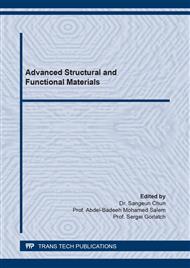p.141
p.151
p.161
p.169
p.179
p.187
p.193
p.199
p.207
Effect of Detergent on Concrete prepared with Periwinkle shell as Coarse Aggregate
Abstract:
The use of the periwinkle shell in the production of lightweight concrete has been studied and accepted to be used for concrete works. Hard water containing detergent-like chemicals has been observed to be used in mixing locally produced concrete. This exploratory study is on the effect of water mixed with detergent in a concrete prepared with the periwinkle shell as a coarse aggregate. A total of 27 concrete cubes of size 150mmx150mmx150mm were prepared in the laboratory with a mix ratio of 1:2:4. A water-cement ratio of 0.4 was used with the addition of detergent at varying percentages (0%, 0.3% and 0.6). The cubes were cured in water and tested at 7days, 14days and 28days respectively. Laboratory tests, which includes bulk density, specific gravity, grain size analysis, slump and the compressive strength test was carried out on the aggregates and concrete. The periwinkle shell had a bulk density of 1440kg/m3and a specific gravity of 2.50. The workability tested revealed that the slump values increased with increase in the percentages of detergent. The compressive strength at 28days and at 0.3% and 0.6% were 12.58N/mm2 and 14.06N/mm2 respectively. It was observed that the compressive strength decreased with the addition of detergent because of the tiny air bubbles introduced into the concrete by the detergent. From the results of the study, it can safely be concluded that the use of detergent contaminated water in concrete production will reduce its compressive strength and increase its workability.
Info:
Periodical:
Pages:
179-186
Citation:
Online since:
June 2021
Authors:
Price:
Сopyright:
© 2021 Trans Tech Publications Ltd. All Rights Reserved
Share:
Citation:


